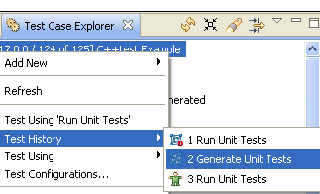...
Safe stub definitions are automatically-generated to replace "dangerous" functions, which includes system I/O routines such as rmdir(), remove(), rename(), etc. In addition, stubs can be automatically generated for missing function and variable definitions (see Understanding and Customizing Automated Stub Generation for details). User-defined stubs can be added as needed (see Adding and Modifying Stubs for details).
Generating Test Cases
| Anchor | ||||
|---|---|---|---|---|
|
...
- Identify or create a Test Configuration with your preferred test generation settings.
- For a description of preconfigured Test Configurations, see Built-in Test Configurations.
- For details on how to create a custom Test Configuration, see the Configuring Test Configurations and Rules for Policies. Details on C++test-specific options are available at Configuring Test Configurations.
- Run the Test Configuration
For details on testing from the GUI, seeTesting from the GUI.
For details on testing from the command line, see Testing from the Command Line Interface.Tip Tip - Generating Tests from the Test Case Explorer
You can generate tests for a project directly from the Test Case Explorer (which can be opened by choosing Parasoft> Show View> Test Case Explorer). Just right-click the project node in the Test Case Explorer, then choose the desired test generation Test Configuration from the Test History or Test Using shortcut menu.
For details about the Test Case Explorer, see Exploring the C++test UI.
- Review the generated test cases.
- For details, seeReviewing Automatically-Generated Test Cases.
- (Optional) Fine-tune test generation settings as needed.
- For details, seeGeneration Tab Settings : - Defining How Test Cases are Generated.
Customizing Generation Options
| Anchor | ||||
|---|---|---|---|---|
|
...
If the Create one test suite per function option is selected, a test suite generated for the sample ATM project (included in the examples directory) would look like this:
If the Create one test suite per tested source/header option is selected, a test suite generated for the sample ATM project (included in the examples directory) would look like this:
...
After selecting one of these options, you can customize the pattern as needed (for instance, to generate tests into the source location). You can use the following variables when you are customizing the pattern:
...
This section explains how to configure the Test suite output file and layout option (in the Test Configuration’s Generation> Test suite tab) to suit various layout needs. To help you understand how each option discussed translates to actual projects, we show how it would affect the following sample project:
| Code Block |
|---|
MyProject
headers
MyClass.h // contains foo() definition
sources
MyClass.cpp // contains bar() and goo() definitions |
To generate a single test suite file for each function, keep tests in a separate directory
...
| Code Block |
|---|
MyProject
headers
MyClass.h
sources
MyClass.cpp
tests
headers
MyClass.h
TestSuite_foo.cpp // contains tests for foo()
sources
MyClass.cpp
TestSuite_bar.cpp // contains tests for bar()
TestSuite_goo.cpp // contains tests for goo() |
Use ${project_loc}/tests/${file_loc_rel}/${file_name}/TestSuite_${function_name}.${test_ext}
Sample layout:
| Code Block |
|---|
MyProject
Header Files
MyClass.h
Source Files
MyClass.cpp
tests
Header Files
MyClass.h
TestSuite_foo.cpp // contains tests for foo()
Source Files
MyClass.cpp
TestSuite_bar.cpp // contains tests for bar()
TestSuite_goo.cpp // contains tests for goo() |
...


